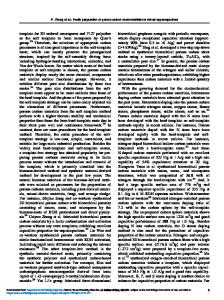Facile construction of honeycomb-shaped porous carbon electrode materials using recyclable sodium chloride template for
- PDF / 3,889,514 Bytes
- 8 Pages / 595.276 x 793.701 pts Page_size
- 52 Downloads / 321 Views
cile construction of honeycomb-shaped porous carbon electrode materials using recyclable sodium chloride template for efficient lithium storage 1
1
1
1
1
1
FANG ShiQing , HE HaoXuan , YU YingHui , LI Xiao , XIE WeiCheng , LI Wei , 1 2 1* JIN LuQiao , YANG ZhenYu & CAI JianXin 1
School of Resources Environmental & Chemical Engineering, Nanchang University, Nanchang 330031, China; 2
College of Chemistry, Nanchang University, Nanchang 330031, China
Received December 26, 2019; accepted March 10, 2020; published online September 8, 2020
Carbon materials are the preferred anode materials for Li-ion batteries. Here, we propose an easy and sustainable strategy to prepare honeycomb-shaped porous carbon (HPC) electrode materials through a process involving simple calcination and subsequent water washing by using polyvinyl-pyrrolidone (PVP) as carbon source and NaCl as pore-forming agent. A controllable cavity size and distribution of the carbon materials can be readily obtained solely by adjusting the NaCl amount. Results showed that the optimized HPC sample had a relatively uniform cavity distribution and a highly porous structure. Moreover, the special honeycomb-shaped structure was conducive to the electronic conductivity of the electrode materials, provided a short path for Li-ion transport and a wide interface with the electrolyte, and buffered the volume change of active materials. The special honeycomb-shaped structure was also maintained well after long cycles, which improved electrode stability. When used as anode materials for Li-ion batteries (LIBs), the sample demonstrated excellent cycling stability and rate performance, with a −1 −1 high specific capacity of 230 mA h g and a reversible capacity of 197 mA h g , after 1200 cycles at 2 C. Overall, we introduced a simple strategy for the potential mass production of porous carbon materials for LIBs. lithium-ion batteries, polyvinyl-pyrrolidone, sodium chloride, honeycomb-shaped, porous carbon materials Citation:
Fang S Q, He H X, Yu Y H, et al. Facile construction of honeycomb-shaped porous carbon electrode materials using recyclable sodium chloride template for efficient lithium storage. Sci China Tech Sci, 2020, 63, https://doi.org/10.1007/s11431-019-1557-2
1 Introduction At present, achieving high energy density Li-ion batteries (LIBs) along with high power density and robust cycle life is considered as the ultimate aim for electric vehicles and gridstorage applications [1–3]. Carbons, silicon, transition-metal oxides, lithium titanate, and tin and their oxides are promising anode materials for LIBs. Among them, typical conversion-type anode materials show high capacities but undergo a considerable volume expansion during Li-ion insertion and extraction, which significantly reduces the sta*Corresponding author (email: [email protected])
bility of the electrode [4]. Meanwhile, lithium titanate shows improved structural stability and security but has a low theoretical capacity, which is far from the current basic requirement of the high capacity and energy
Data Loading...











